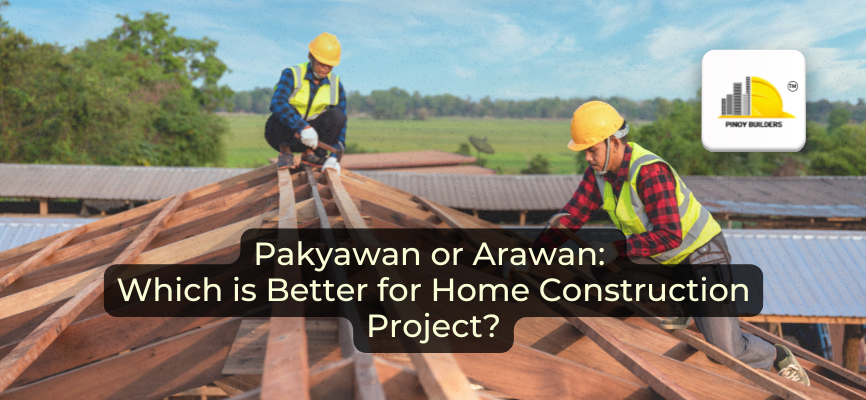For many individuals, a home is one of the biggest investments they could make in their lifetime. Careful planning and consideration are a must in ensuring every peso going into the construction of their future home is worth it.
One of the many things a homeowner in the country should consider is the price that they are to pay for the services they will avail from a contractor. In the Philippines, homeowners will usually hear two (2) terms in construction project pricing: pakyaw and arawan.
We’ll be looking at the pakyawan and arawan in Philippine construction, and which one a homeowner should invest in for their home construction projects.
What is Pakyawan?
Pakyawan or pakyaw agreement is an agreement between the homeowner and contractor where the latter completes the construction project for a fixed or specified price – regardless of labor costs and changes in material. Most often, this method will require the contractor to issue a contract. Both parties get a written agreement stating the discussed price and any other dues that either party has to settle. Contracts are preferred in a pakyawan setting, so that all terms are clear between both parties.
Pakyawan: Advantages and Disadvantages
Both clients and contractors agree to a fixed rate in pakyawan, including the job and the desired outcome. While there are advantages to using pakyawan as a construction method, it’s also wise to consider it as a whole.
Advantages:
- Documentation – All agreements and information are documented for reference of the client and of the contractor. This ensures that both parties agree on all elements of the project, as this will avoid any misunderstandings from occurring – especially with commitments, obligations, duties, and responsibilities.
- Efficiency – It saves time and effort. With the pakyawan method, clients and contractors don’t have to go back-and-forth with changes in the agreement or changes in prices because of the fixed amount to be paid. It also doesn’t stop operations because of factors, like the increase in prices of the materials to be used. Work gets completed much faster, saving time and energy.
- Teamwork – There is a shared effort between the contractor and the client to make sure that the project goes smoothly. The contractor oversees the daily operations and ensures they follow through all commitments, while the project owner oversees the funding and the administrative duties of the project.
Disadvantages:
- Vagueness – While everything has to be done according to contract, the contractor can contest any vague element of the project. Assuming there are inconsistencies in the project, a contractor can argue it as not being a part of the contract. Specify all details in the contract – even the minor details – to eliminate discrepancies.
- Work Inflexibility – Pakyawan, again, relies on the contract. They must agree on all scopes and limitations within the project upon to not incur additional charges. The contractor may ask for compensation should the client require them to do a service that is not included in the contract. Likewise, the client can deny dispute additional charges being asked of them if they did not agree to it.
- Contingent Costs – Because of pakyawan’s nature, there might be factors or variables that may increase the project’s job estimate. Some of these variables may or may not happen throughout the project – even with the presence of a contract – and the overall price will still be the same.

What is Arawan?
Arawan means paying that workers on a daily or weekly basis, depending on the agreement. For this method, the contractor and the homeowners will have a pre-specified rate of compensation, based on the time spent on the project. While some contractors do issue paperwork or contracts for arawan projects, you might encounter those that won’t issue them which can be dangerous for the homeowner as they won’t have claims to back them up on the event that there are discrepancies with the construction project or if the result was not what was expected. Still, this might be a more economical option for those who are looking to have smaller projects done because it won’t need long hours.
Arawan: Advantages and Disadvantages
Arawan might be more convenient for those who are on a budget, or those who aren’t looking for a large-scale project. It also has its advantages and disadvantages, which are:
Advantages:
- Faster Delivery of Services – Arawan usually skips the time-consuming processes of a construction project which might include any assessments, reviews, or approvals. It entails faster delivery of services, especially when it involves any urgent repairs or installations.
- Economical – As mentioned, arawan is a more affordable – especially for those who need immediate services. Further, most clients also don’t have to pay other fees (e.g. taxes and government imposed fees) and can course their payments directly to the contractor.
- Controlled Phasing – The arawan method lets the client or project owner set the pace for the construction project. They can choose to focus on a certain area at once and can also take control of the budget allocation for each phase or area of the construction project.
Disadvantages:
- Litigations – Remember that, as opposed to pakyawan, arawan can be informal. Workers can easily leave the project anytime to work on other projects. Project owners and clients might also encounter legal charges in case something comes up with the arrangement.
- Quality Control – While it isn’t always the case, workers might cut corners in doing their work because of arawan. Since it’s unlikely that the client or project owner will do regular checks.
- Affordability – Despite arawan being the more affordable method between the two, it may cost more when the project owner is inexperienced or is not familiar with construction costs. Should the client or project owner not be familiar with construction terms and costs, they won’t get the desired affordability.

Pakyawan or Arawan: Which is Better for House Construction?
In all entirety, it depends on the project owner or the client. Both are great for those in a budget or for those looking for quick construction projects, but we recommend consulting with a contractor about the jobs that have to be done with their home construction projects – regardless of what method they choose. It always helps to have a professional opinion, especially when starting a construction project at home, as budgeting for construction is no simple task.
For homeowners or project owners who are not so familiar with dealings within the construction industry, stick with pakyawan. It still entails collaboration with your contractor. However, if you’re willing to take the risk or if it’s just a small renovation project, you can opt for arawan as it is the cheaper option. It would still be appropriate for dealings to be discussed with a contractor before proceeding with your preferred payment method.
Do you want to see more content like this in the future? Subscribe to Pinoy Builders for FREE today and stay in the loop for the latest news and updates on the Philippine construction industry!
Sources:
- Butler, M. (2021, September 21). Arawan vs. Pakywan: Which is the best for you? Mr. Butler. https://mrbutler.com.ph/uncategorized/by-the-hour-arawan-vs-by-the-job-pakyawan-which-pricing-method-is-the-best-for-you/
- Coloma III, Atty. J. (2018, December 12). A Guide to Construction and Renovation Contracts. BluPrint. https://bluprint.onemega.com/a-guide-to-construction-and-renovation-contracts/
- Construction Tips. (n.d.). Modcontech Builders. https://www.modcontech.com/tips










